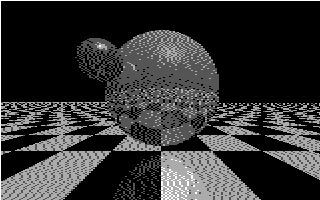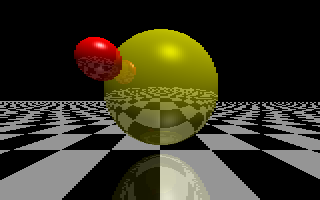C64 Programming
Perhaps this also falls under "Raytracing / Image Synthesis", but I decided
it deserved its own section. :-) I have also started work on a raytracer
that can run on a C64. If you don't know a lot about raytracing, it may
surprise you that it requires very little memory to calculate a very
interesting image. In fact, it is possible to use procedural objects and
textures to avoid large data sets. Since I haven't seen a "real" raytracer on
the C64, I decided to write one.
The C64 has an 8-bit 6510 processor (same instruction set as the
6502). It runs at just under 1Mhz!! I thought that I might be able to write
the raytracer in C64 Basic, but I scrapped that idea because the raytracer would
be extremely slow, and C64 Basic doesn't even have functions! It
would be very difficult to write a raytracer in the language even if speed
wasn't an issue. So, I decided to write the raytracer using cc65 (an almost C
compiler).
My next problem was figuring out how to perform floating point math operations.
The cc65 compiler doesn't support any floating point number formats. So, I had
to perform these operations without the compiler.
Also, the 6502 doesn't handle floating point numbers like most current
processors. In fact, the processor doesn't even have a multiplication
instruction. But, the Basic language does support floating point numbers. So,
I wrote functions in C/Assembly that "stuff" the areas in memory that
Basic uses as floating point registers. Then I call the Basic ROM routines to
calculate the result for me.

Initially my program just rasterized a sphere (i.e. no rays were cast). As you
can see, I must dither the image so I can display it on the C64. It takes
almost 30min for the sphere to render on a C64! Luckily I can run the program
much faster on my PC using a C64 emulator. I am also able to run the raytracer
natively on my PC. I placed all the machine specific code in different
modules, so I am able to compile the raytracer for the C64 or under Linux.
|

Here is a much newer image I generated. This time I am actually ray tracing
instead of rasterizing the image. The raytracer now supports two types of
primitives; spheres and planes. The raytracer also supports different material
types. At the moment it supports a base material that contains diffuse colour,
specular colour, and reflectivity attributes. I also have a checkerboard material
that is almost the same as the base material, but it has two different diffuse
colours.
|

Here you can see a true-colour version of the scene show above. I have modified
the raytracer so it writes images out to disk as true colour PPM files. The
image here was actally rendered on the c64.
I didn't precisely time how long this image took to render, but I think it
would take about five hours to render on a c64. My 800Mhz Athlon renders the
same image in about two seconds!
|

Here is another image showing the latest features of my raytracer. Now, the
raytracer supports shadows properly. I also changed the scene I was raytracing
a bit (so that the FOV looks better).
|
|



